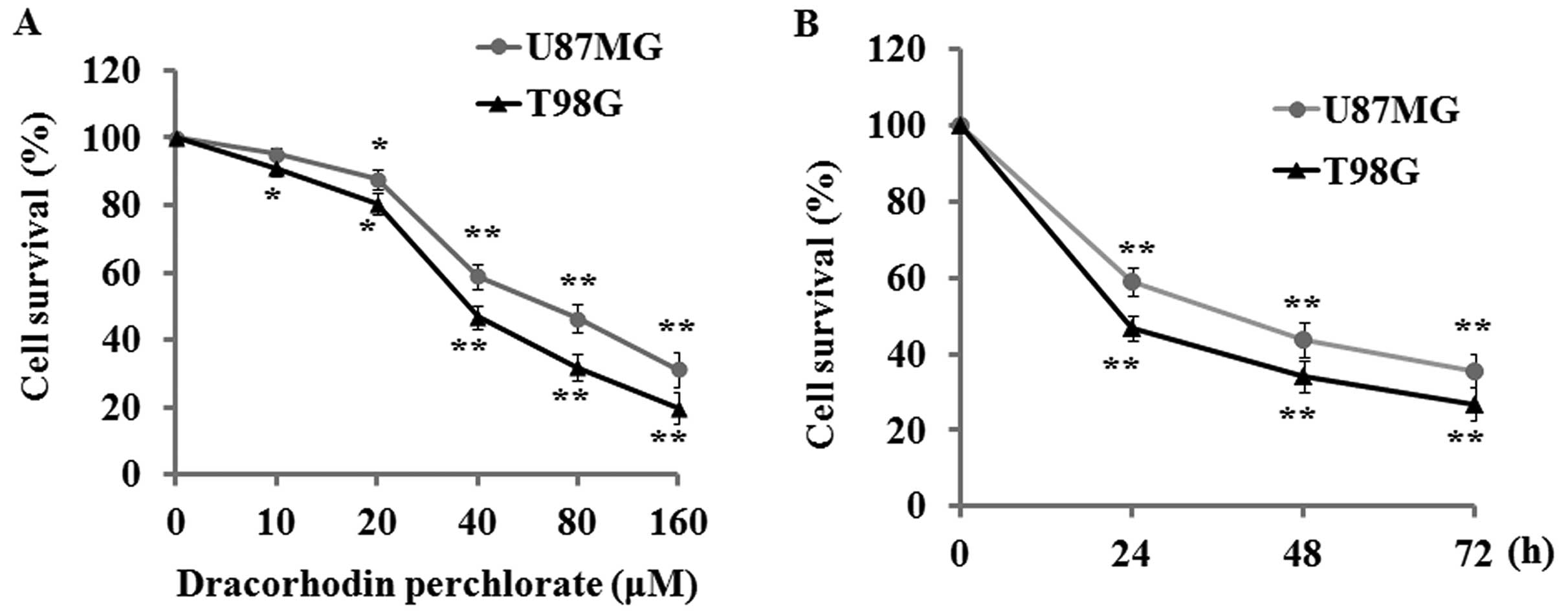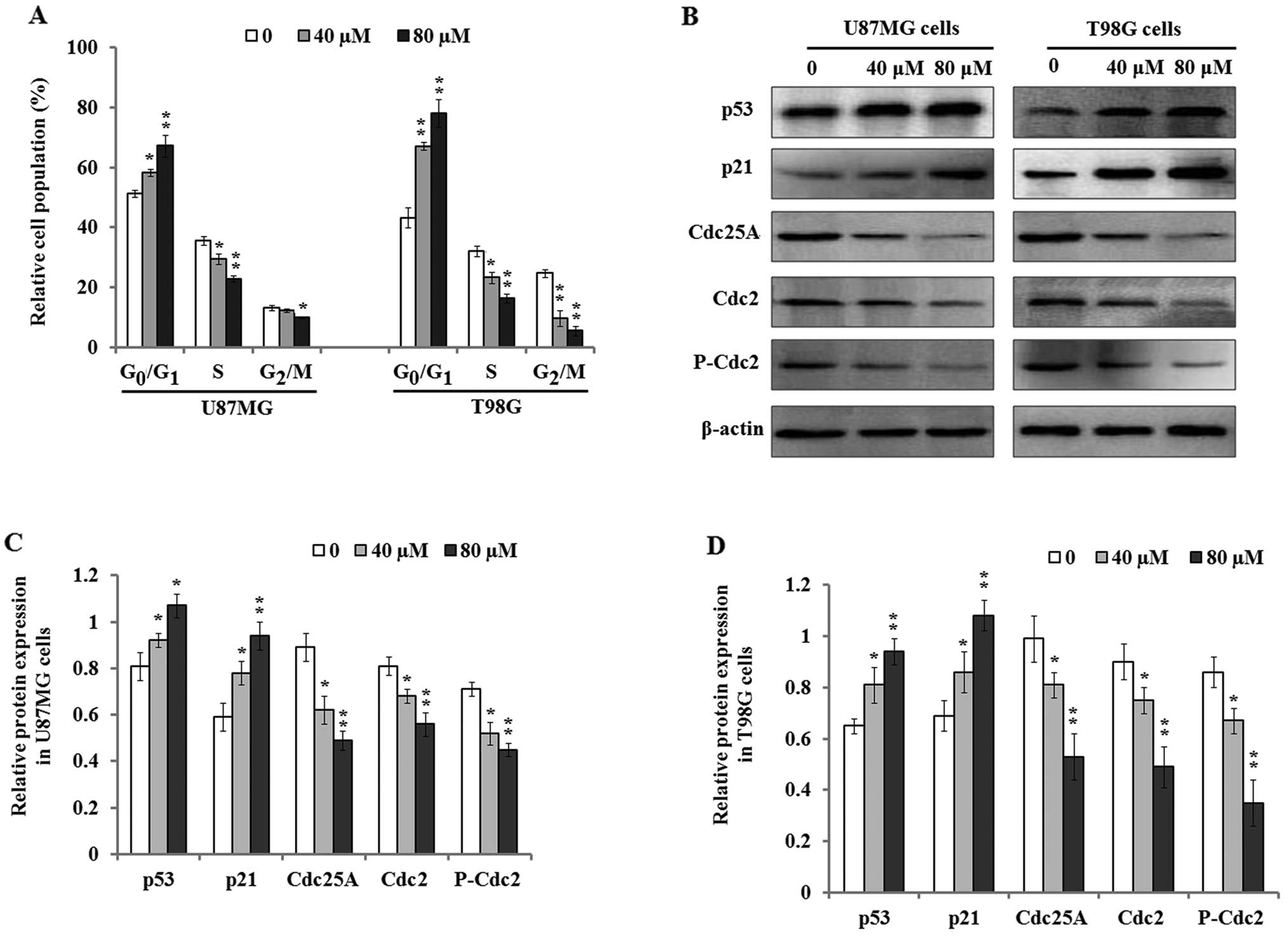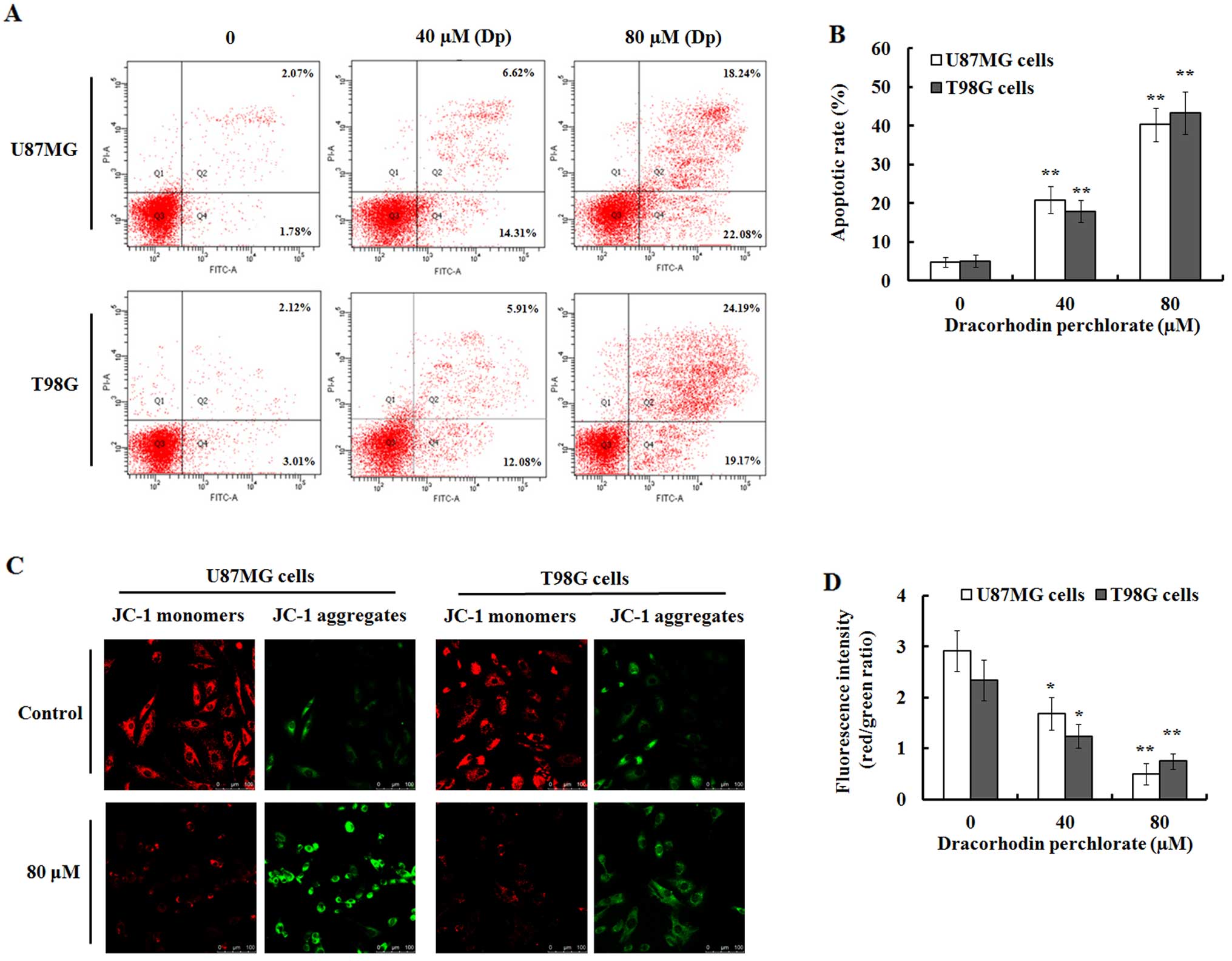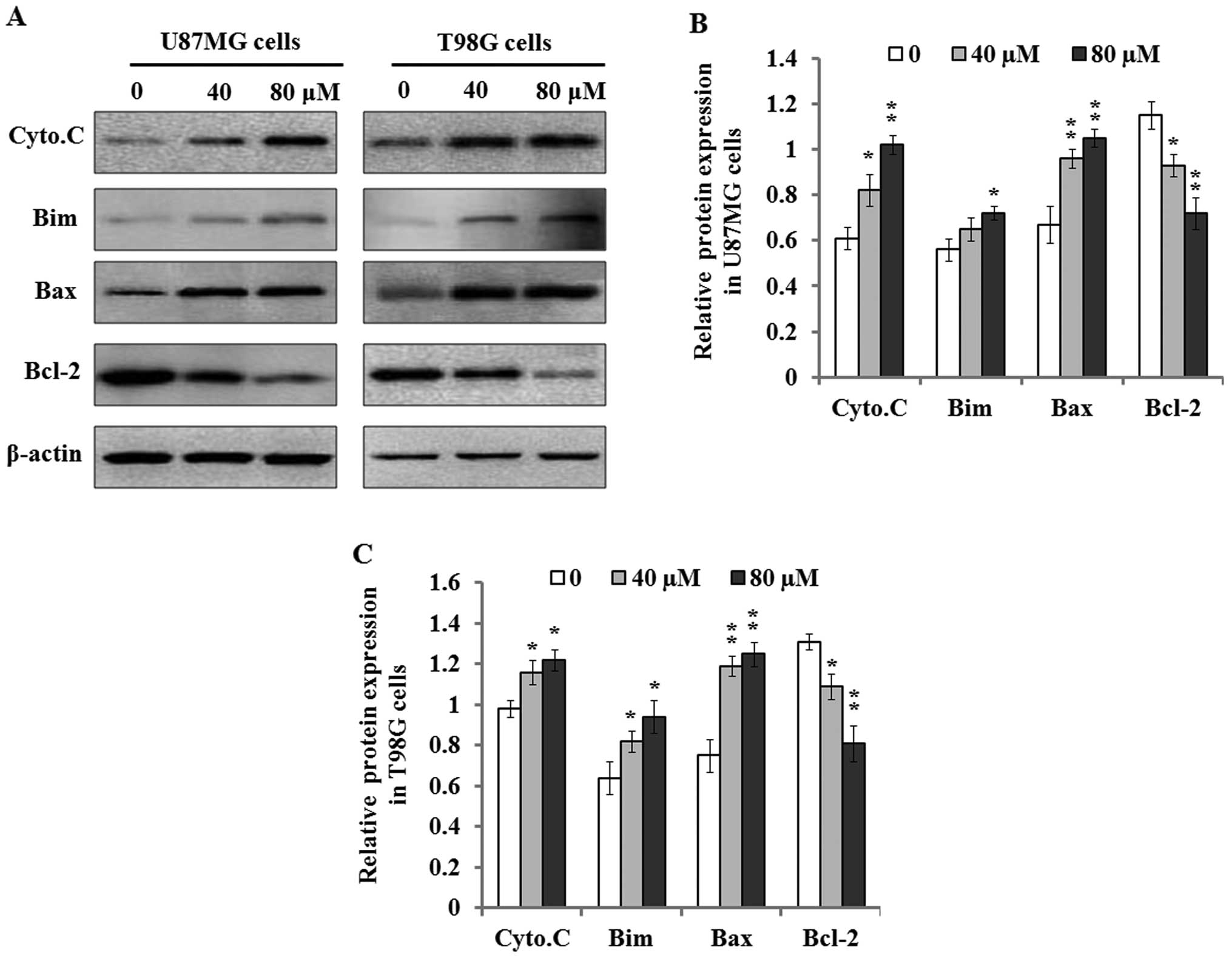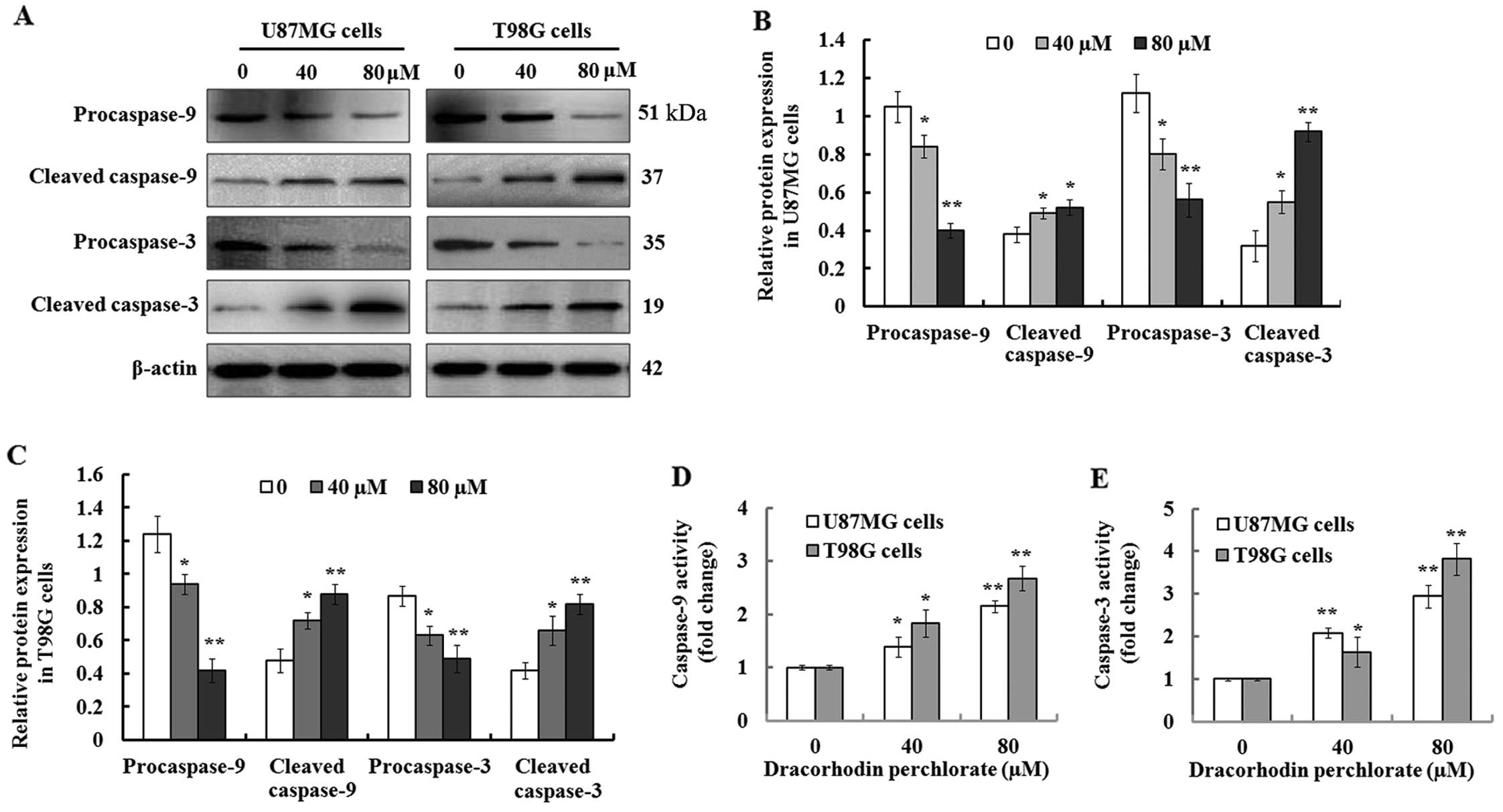|
1
|
Guo X, Fan W, Bian X and Ma D:
Upregulation of the Kank1 gene-induced brain glioma apoptosis and
blockade of the cell cycle in G0/G1 phase. Int J Oncol. 44:797–804.
2014.PubMed/NCBI
|
|
2
|
Li Q, Shen K, Zhao Y, Ma C, Liu J and Ma
J: miR-92b inhibitor promoted glioma cell apoptosis via targeting
DKK3 and blocking the Wnt/beta-catenin signaling pathway. J Transl
Med. 11:3022013. View Article : Google Scholar : PubMed/NCBI
|
|
3
|
Xu C, Sun G, Yuan G, Wang R and Sun X:
Effects of platycodin D on proliferation, apoptosis and PI3K/Akt
signal pathway of human glioma U251 cells. Molecules.
19:21411–21423. 2014. View Article : Google Scholar : PubMed/NCBI
|
|
4
|
Sun T, Zhang Z, Li B, Chen G, Xie X, Wei
Y, Wu J, Zhou Y and Du Z: Boron neutron capture therapy induces
cell cycle arrest and cell apoptosis of glioma stem/progenitor
cells in vitro. Radiat Oncol. 8:1952013. View Article : Google Scholar : PubMed/NCBI
|
|
5
|
Shang C, Hong Y, Guo Y, Liu YH and Xue YX:
miR-210 up-regulation inhibits proliferation and induces apoptosis
in glioma cells by targeting SIN3A. Med Sci Monit. 20:2571–2577.
2014. View Article : Google Scholar : PubMed/NCBI
|
|
6
|
Knizhnik AV, Roos WP, Nikolova T, Quiros
S, Tomaszowski KH, Christmann M and Kaina B: Survival and death
strategies in glioma cells: Autophagy, senescence and apoptosis
triggered by a single type of temozolomide-induced DNA damage. PLoS
One. 8:e556652013. View Article : Google Scholar : PubMed/NCBI
|
|
7
|
Sharma A, Sharma DN, Julka PK and Rath GK:
Treatment options in elderly patients with glioblastoma. Lancet
Oncol. 13:e460–e461; author reply e461–e462. 2012. View Article : Google Scholar : PubMed/NCBI
|
|
8
|
Mhaidat NM, Bouklihacene M and Thorne RF:
5-Fluorouracil-induced apoptosis in colorectal cancer cells is
caspase-9-dependent and mediated by activation of protein kinase
C-δ. Oncol Lett. 8:699–704. 2014.PubMed/NCBI
|
|
9
|
Auyeung KK, Cho CH and Ko JK: A novel
anticancer effect of Astragalus saponins: Transcriptional
activation of NSAID-activated gene. Int J Cancer. 125:1082–1091.
2009. View Article : Google Scholar : PubMed/NCBI
|
|
10
|
Ando M, Yonemori K, Katsumata N, Shimizu
C, Hirata T, Yamamoto H, Hashimoto K, Yunokawa M, Tamura K and
Fujiwara Y: Phase I and pharmacokinetic study of nab-paclitaxel,
nanoparticle albumin-bound paclitaxel, administered weekly to
Japanese patients with solid tumors and metastatic breast cancer.
Cancer Chemother Pharmacol. 69:457–465. 2012. View Article : Google Scholar
|
|
11
|
Rao GS, Gerhart MA, Lee RT III, Mitscher
LA and Drake S: Antimicrobial agents from higher plants. Dragon's
blood resin. J Nat Prod. 45:646–648. 1982. View Article : Google Scholar : PubMed/NCBI
|
|
12
|
Zhang P, Li J, Tang X, Zhang J, Liang J
and Zeng G: Dracorhodin perchlorate induces apoptosis in primary
fibroblasts from human skin hypertrophic scars via participation of
caspase-3. Eur J Pharmacol. 728:82–92. 2014. View Article : Google Scholar : PubMed/NCBI
|
|
13
|
He Y, Ju W, Hao H, Liu Q, Lv L and Zeng F:
Dracorhodin perchlorate suppresses proliferation and induces
apoptosis in human prostate cancer cell line PC-3. J Huazhong Univ
Sci Technolog Med Sci. 31:215–219. 2011. View Article : Google Scholar : PubMed/NCBI
|
|
14
|
Rasul A, Ding C, Li X, Khan M, Yi F, Ali M
and Ma T: Dracorhodin perchlorate inhibits PI3K/Akt and NF-κB
activation, up-regulates the expression of p53, and enhances
apoptosis. Apoptosis. 17:1104–1119. 2012. View Article : Google Scholar : PubMed/NCBI
|
|
15
|
Yu JH, Zheng GB, Liu CY, Zhang LY, Gao HM,
Zhang YH, Dai CY, Huang L, Meng XY, Zhang WY, et al: Dracorhodin
perchlorate induced human breast cancer MCF-7 apoptosis through
mitochondrial pathways. Int J Med Sci. 10:1149–1156. 2013.
View Article : Google Scholar : PubMed/NCBI
|
|
16
|
Xia M, Wang M, Tashiro S, Onodera S,
Minami M and Ikejima T: Dracorhodin perchlorate induces A375-S2
cell apoptosis via accumulation of p53 and activation of caspases.
Biol Pharm Bull. 28:226–232. 2005. View Article : Google Scholar : PubMed/NCBI
|
|
17
|
Xia MY, Wang MW, Cui Z, Tashiro SI,
Onodera S, Minami M and Ikejima T: Dracorhodin perchlorate induces
apoptosis in HL-60 cells. J Asian Nat Prod Res. 8:335–343. 2006.
View Article : Google Scholar : PubMed/NCBI
|
|
18
|
Yan YY, Bai JP, Xie Y, Yu JZ and Ma CG:
The triterpenoid pristimerin induces U87 glioma cell apoptosis
through reactive oxygen species-mediated mitochondrial dysfunction.
Oncol Lett. 5:242–248. 2013.
|
|
19
|
Bai Y, Mao QQ, Qin J, Zheng XY, Wang YB,
Yang K, Shen HF and Xie LP: Resveratrol induces apoptosis and cell
cycle arrest of human T24 bladder cancer cells in vitro and
inhibits tumor growth in vivo. Cancer Sci. 101:488–493. 2010.
View Article : Google Scholar
|
|
20
|
Wu H, Jiang H, Lu D, Xiong Y, Qu C, Zhou
D, Mahmood A and Chopp M: Effect of simvastatin on glioma cell
proliferation, migration, and apoptosis. Neurosurgery.
65:1087–1096; discussion 1096–1097. 2009. View Article : Google Scholar : PubMed/NCBI
|
|
21
|
Selvaraj V, Armistead MY, Cohenford M and
Murray E: Arsenic trioxide (As2O3) death
through mitochondrial membrane potential damage and induces
apoptosis and necrosis mediated cell elevated production of
reactive oxygen species in PLHC-1 fish cell line. Chemosphere.
90:1201–1209. 2013. View Article : Google Scholar
|
|
22
|
Zhou L, Guo X, Chen M, Fu S, Zhou J, Ren
G, Yang Z and Fan W: Inhibition of δ-opioid receptors induces brain
glioma cell apoptosis through the mitochondrial and protein kinase
C pathways. Oncol Lett. 6:1351–1357. 2013.PubMed/NCBI
|
|
23
|
Li ZH, Yu Y, DU C, Fu H, Wang J and Tian
Y: RNA inter-ference-mediated USP22 gene silencing promotes human
brain glioma apoptosis and induces cell cycle arrest. Oncol Lett.
5:1290–1294. 2013.PubMed/NCBI
|
|
24
|
Malekinejad H, Moradi M and Fink-Gremmels
J: Cytochrome C and caspase-3/7 are involved in mycophenolic
acid-induced apoptosis in genetically engineered PC12 neuronal
cells expressing the p53 gene. Iran J Pharm Res. 13:191–198.
2014.PubMed/NCBI
|
|
25
|
Kheirollahi M, Mehr-Azin M, Kamalian N and
Mehdipour P: Expression of cyclin D2, P53, Rb and ATM cell cycle
genes in brain tumors. Med Oncol. 28:7–14. 2011. View Article : Google Scholar
|
|
26
|
Shieh JM, Huang TF, Hung CF, Chou KH, Tsai
YJ and Wu WB: Activation of c-Jun N-terminal kinase is essential
for mito-chondrial membrane potential change and apoptosis induced
by doxycycline in melanoma cells. Br J Pharmacol. 160:1171–1184.
2010. View Article : Google Scholar : PubMed/NCBI
|
|
27
|
McStay GP and Green DR: Measuring
apoptosis: Caspase inhibitors and activity assays. Cold Spring Harb
Protoc. 2014:799–806. 2014.PubMed/NCBI
|
|
28
|
Wen PY and Kesari S: Malignant gliomas in
adults. N Engl J Med. 359:492–507. 2008. View Article : Google Scholar : PubMed/NCBI
|
|
29
|
Liu WT, Huang CY, Lu IC and Gean PW:
Inhibition of glioma growth by minocycline is mediated through
endoplasmic reticulum stress-induced apoptosis and autophagic cell
death. Neuro Oncol. 15:1127–1141. 2013. View Article : Google Scholar : PubMed/NCBI
|
|
30
|
Shi J, Hu R, Lu Y, Sun C and Wu T:
Single-step purification of dracorhodin from dragon's blood resin
of Daemonorops draco using high-speed counter-current
chromatography combined with pH modulation. J Sep Sci.
32:4040–4047. 2009. View Article : Google Scholar : PubMed/NCBI
|
|
31
|
Kruse JP and Gu W: Modes of p53
regulation. Cell. 137:609–622. 2009. View Article : Google Scholar : PubMed/NCBI
|
|
32
|
Armstrong MJ, Stang MT, Liu Y, Gao J, Ren
B, Zuckerbraun BS, Mahidhara RS, Xing Q, Pizzoferrato E and Yim JH:
Interferon regulatory factor 1 (IRF-1) induces p21(WAF1/CIP1)
dependent cell cycle arrest and p21(WAF1/CIP1) independent
modulation of survivin in cancer cells. Cancer Lett. 319:56–65.
2012. View Article : Google Scholar :
|
|
33
|
Sykes SM, Mellert HS, Holbert MA, Li K,
Marmorstein R, Lane WS and McMahon SB: Acetylation of the p53
DNA-binding domain regulates apoptosis induction. Mol Cell.
24:841–851. 2006. View Article : Google Scholar : PubMed/NCBI
|
|
34
|
Tang Y, Luo J, Zhang W and Gu W:
Tip60-dependent acetylation of p53 modulates the decision between
cell-cycle arrest and apoptosis. Mol Cell. 24:827–839. 2006.
View Article : Google Scholar : PubMed/NCBI
|
|
35
|
Tu YS, Kang XL, Zhou JG, Lv XF, Tang YB
and Guan YY: Involvement of Chk1-Cdc25A-cyclin A/CDK2 pathway in
simvastatin induced S-phase cell cycle arrest and apoptosis in
multiple myeloma cells. Eur J Pharmacol. 670:356–364. 2011.
View Article : Google Scholar : PubMed/NCBI
|
|
36
|
Watanabe G, Behrns KE, Kim JS and Kim RD:
Heat shock protein 90 inhibition abrogates hepatocellular cancer
growth through cdc2-mediated G2/M cell cycle arrest and apoptosis.
Cancer Chemother Pharmacol. 64:433–443. 2009. View Article : Google Scholar
|
|
37
|
Tomita Y, Marchenko N, Erster S,
Nemajerova A, Dehner A, Klein C, Pan H, Kessler H, Pancoska P and
Moll UM: WT p53, but not tumor-derived mutants, bind to Bcl2 via
the DNA binding domain and induce mitochondrial permeabilization. J
Biol Chem. 281:8600–8606. 2006. View Article : Google Scholar : PubMed/NCBI
|
|
38
|
Kassi E, Sourlingas TG, Spiliotaki M,
Papoutsi Z, Pratsinis H, Aligiannis N and Moutsatsou P: Ursolic
acid triggers apoptosis and Bcl-2 downregulation in MCF-7 breast
cancer cells. Cancer Invest. 27:723–733. 2009. View Article : Google Scholar : PubMed/NCBI
|
|
39
|
Das S, Dey KK, Bharti R, MaitiChoudhury S,
Maiti S and Mandal M: PKI 166 induced redox signalling and
apoptosis through activation of p53, MAP kinase and caspase pathway
in epidermoid carcinoma. J Exp Ther Oncol. 10:139–153. 2012.
|
|
40
|
Breckenridge DG and Xue D: Regulation of
mitochondrial membrane permeabilization by BCL-2 family proteins
and caspases. Curr Opin Cell Biol. 16:647–652. 2004. View Article : Google Scholar : PubMed/NCBI
|
|
41
|
Feng R, Han J, Ziegler J, Yang M and
Castranova V: Apaf-1 deficiency confers resistance to
ultraviolet-induced apoptosis in mouse embryonic fibroblasts by
disrupting reactive oxygen species amplification production and
mitochondrial pathway. Free Radic Biol Med. 52:889–897. 2012.
View Article : Google Scholar : PubMed/NCBI
|















